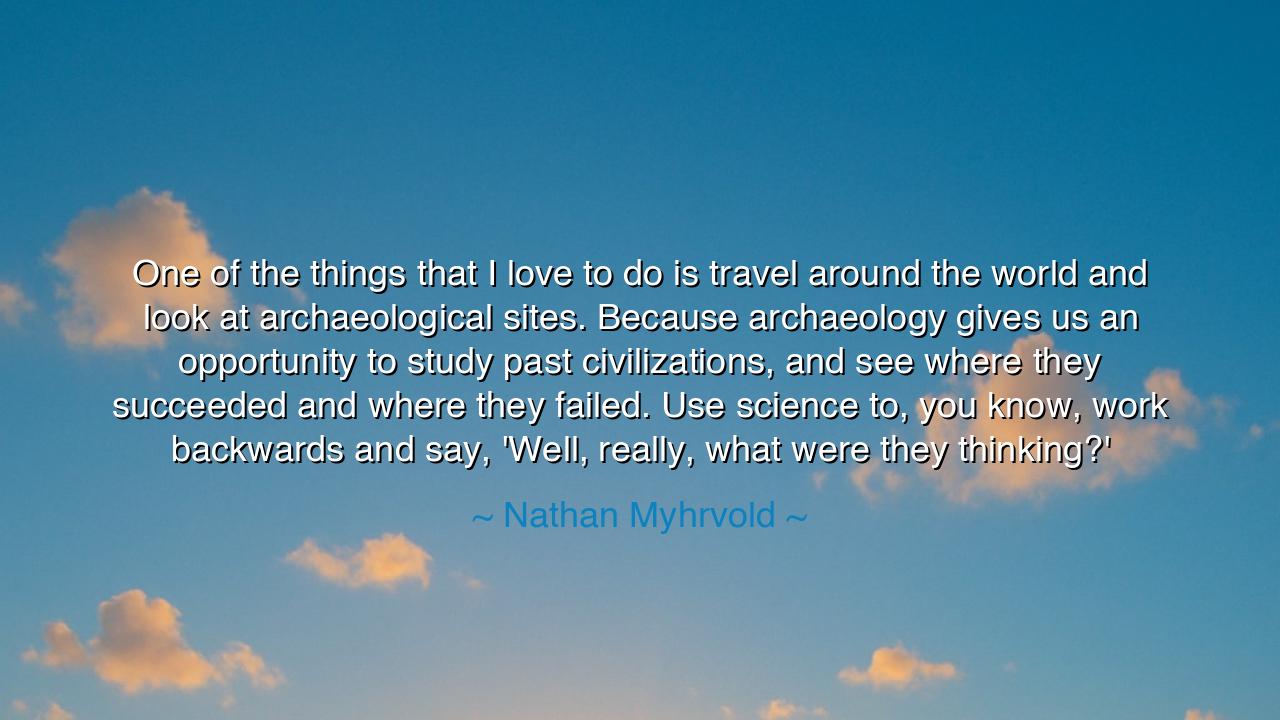
One of the things that I love to do is travel around the world
One of the things that I love to do is travel around the world and look at archaeological sites. Because archaeology gives us an opportunity to study past civilizations, and see where they succeeded and where they failed. Use science to, you know, work backwards and say, 'Well, really, what were they thinking?'






The words of Nathan Myhrvold shine like a torch lifted high against the night: “One of the things that I love to do is travel around the world and look at archaeological sites. Because archaeology gives us an opportunity to study past civilizations, and see where they succeeded and where they failed. Use science to, you know, work backwards and say, ‘Well, really, what were they thinking?’” These words reveal the sacred desire of the human spirit: to understand the footsteps of those who came before us, to peer into their struggles and triumphs, and to wrest wisdom from the ruins of time.
For the ancients themselves were ever mindful of memory. The Egyptians carved their chronicles into stone so that even the desert winds could not erase them. The Greeks raised temples, not only for their gods but for the enduring story of their people. The Mayans inscribed their glyphs upon stelae, knowing that their voices might carry beyond their own age. And yet, even with all this, civilizations rose and fell, their streets swallowed by sands, their palaces consumed by jungle, their voices fading into silence. It is the task of archaeology to bend low, to uncover these buried whispers, and to ask with reverence: “What were they thinking?”
Consider the city of Pompeii, which lay hidden beneath ash for nearly two thousand years. When uncovered, it revealed not only monuments and temples but bakeries, graffiti, and the small tokens of daily life. From these remnants, we glimpse not gods alone, but ordinary men and women—their joys, their faults, their loves, their fears. In the ruins, we see both success and failure, both vitality and fragility. Through the gaze of science and the patience of excavation, we look backwards—not with scorn, but with awe—and realize that their story is a mirror of our own.
The meaning of the quote lies here: that to study the dead is not to linger in dust, but to illuminate the living. To know how empires thrived is to see the seeds of flourishing in our own time. To see how they crumbled is to guard against repeating their errors. Myhrvold reminds us that the ruins are not mute stones but teachers, that in their silence lies the deepest counsel. The city that mismanaged its water, the kingdom that overreached in war, the people who neglected their soil—all cry out lessons to us, if only we are humble enough to listen.
And yet, this labor requires not only science but imagination. To ask, “What were they thinking?” is to breathe life back into the bones of history. It is to stand upon the fallen walls and remember that men and women once dreamed there, once loved their children, once longed for the future just as we do. Their failures are warnings, but their triumphs are beacons. The Parthenon still whispers of beauty; the aqueducts of Rome still boast of ingenuity; the pyramids still proclaim the reach of vision. Each site is both grave and testament, both caution and inspiration.
The story of Heinrich Schliemann, the 19th-century discoverer of Troy, reminds us of this. Though ridiculed for believing that Homer’s epics contained truth, he persisted. His spade uncovered walls and treasures that proved legend had roots in history. His passion showed that to explore the ruins is also to rekindle human imagination, to join myth with reality, and to remind us that even in collapse, civilizations speak to us across millennia.
So what lesson should we carry? That we must not walk blindly through time, repeating endlessly the errors of those before us. Instead, let us seek out the ruins—whether through books, journeys, or museums—and listen for their wisdom. Let us use the tools of science, but also the eyes of reverence, to piece together the mosaic of the past. And in our own lives, let us remember: we too are building civilizations, whether in our families, our communities, or our nations. Future generations will study us and ask, “What were they thinking?” May we live so that the answer shines with courage, wisdom, and care.
For in the end, the broken stones of ancient cities are not merely relics—they are mirrors. And when we gaze into them, we do not only see the dead, but ourselves.






AAdministratorAdministrator
Welcome, honored guests. Please leave a comment, we will respond soon